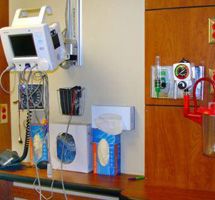- Clinical Technology
- Adult Immunization
- Hepatology
- Pediatric Immunization
- Screening
- Psychiatry
- Allergy
- Women's Health
- Cardiology
- Pediatrics
- Dermatology
- Endocrinology
- Pain Management
- Gastroenterology
- Infectious Disease
- Obesity Medicine
- Rheumatology
- Nephrology
- Neurology
- Pulmonology
What’s New in Asthma Management? An Update on Education and Feedback

What’s new in how to help patients, their parents, and their peers better manage asthma?
Here, Barbara Yawn, MD, MSc, summarizes recent studies on asthma education and self-management. She comments on the implications for modifying disease management behavior in hard-to-reach populations.
________________________________________________________
School-Based Asthma Programs for Teens are Helpful
Asthma Self-Management for Adolescents (ASMA)- an 8-week school-based program -increased knowledge and self- management skills and confidence among inner city African American and Hispanic teens that decreased ED and urgent care use and missed activity days.
What the results suggest: School is a good place to help support these programs and this is an important approach to consider in a group we do not often see in the office. But with the cost cutting most schools are experiencing, we may need to find volunteers who can support such education. Do you know anyone at your local/regional American Lung Association who might be interested?
Source: Bruzzese JM, Sheares BJ, Vincent EJ, Du Y, et al. Effects of a school-based intervention for urban adolescents with asthma. A controlled trial. Am J Respir Crit Care Med. 2011;183:998-1006.
Peer-to-Peer Education Program Helps Underserved Teens
A teen peer-led asthma program implemented at day-camp can improve attitude and quality of life in teens with asthma, especially young men and teens of low socioeconomic status-some of the hardest groups to “reach.” The conventional adult-led program was not as effective.
What the results suggest: Can you do anything to facilitate such a program for your community’s middle and high school(s)? Are there other “natural” venues where teens gather that might serve a similar purpose? Are there groups in the community that might help, such as Big Brothers/Big Sisters?
Source: Rhee H, Belyea MJ, Hunt JF, Brasch J. Effects of a peer-led asthma self-management program for adolescents. Arch Pediatr Adolesc Med. 2011;165:513-519.
Self-Management ED Program Didn’t Help
Asthma self-management education was successfully provided in the ED during asthma exacerbation visits and reinforced by telephone follow-up. Control and intervention patients had sustained improvements in clinical status at 16 weeks. There was no incremental benefit, however, for quality of life and short-term repeat ED visit outcomes.
What the results suggest: The study doesn’t negate the need for us to talk with patients in the ED, explain how and why they may have gotten there, (poor adherence, poor inhaler technique, triggers or maybe not enough medications), and describe why they need the steroid burst and how to avoid triggers. A short talk is an absolute must. But to reap durable rewards, the full blown education program may need to take place incrementally over several office visits-where that’s possible.
Source: Mancuso CA, Peterson MG, Gaeta TJ, et al. A randomized controlled trial of self-management education for asthma patients in the emergency department. Ann Emerg Med. 2011;57:603-612.

Parental Coaching Increased Monitoring, but Didn’t Decrease ED Visits
An intensive coaching intervention for parents of children with asthma increased outpatient monitoring visits, but only slightly. Rates for ED visits and hospitalizations were the same for intervention and control groups.
What the results suggest: Coaching parents on how to better care for a child’s asthma should certainly continue. Despite the flexibility of the current intervention to accommodate parents’ schedules, however, obstacles remain in this hard-to-reach population. Every outpatient visit is a chance to learn more about how a particular household works, or doesn’t work and to try, or suggest, another tactic. The results remind us that our work to ensure continuity of care is ongoing.
Source: Nelson KA, Highstein GR, Garbutt J, et al. A randomized controlled trial of parental asthma coaching to improve outcomes among urban minority children. Arch Pediatr Adolesc Med. 2011;165:520-526.
Feedback for Parents on Toxins in Children’s Urine Did Not Improve Smoking Cessation
We can measure children’s exposure to second hand smoke with urine testing. But, a community intervention that supported parents smoking cessation efforts and gave them feedback on their child’s urine nicotine level did not improve smoking cessation except in the families of children with history of multiple ED or hospital visits.
What the results suggest: Frustrating! But don’t give up trying to get parents of children with asthma to stop smoking or at least get them to smoke outside the home and not smoke in the car!
Source: Wilson SR, Farber HJ, Knowles SB, Lavori PW. A randomized trial of parental behavioral counseling and cotinine feedback for lowering environmental tobacco smoke exposure in children with asthma: results of the LET'S Manage Asthma trial. Chest. 2011;139:581-590.
Technology Doesn’t Trump Responsibility
And by the way, air cleaners do not remove second hand smoke from the environment. In settings where children with asthma were exposed to second hand smoke and air cleaners were installed, symptom-free days did increase but both urine cotinine and air nicotine levels were unchanged. Easing of symptoms was most likely the result of reduced concentration in airborne particulate matter, not in the level of toxins.
What the results suggest: Clean up doesn’t work. Cessation does.
Source: Butz AM, Matsui EC, Breysse P, et al. A randomized trial of air cleaners and a health coach to improve indoor air quality for inner-city children with asthma and secondhand smoke exposure. Arch Pediatr Adolesc Med. 2011;165:741-748.
